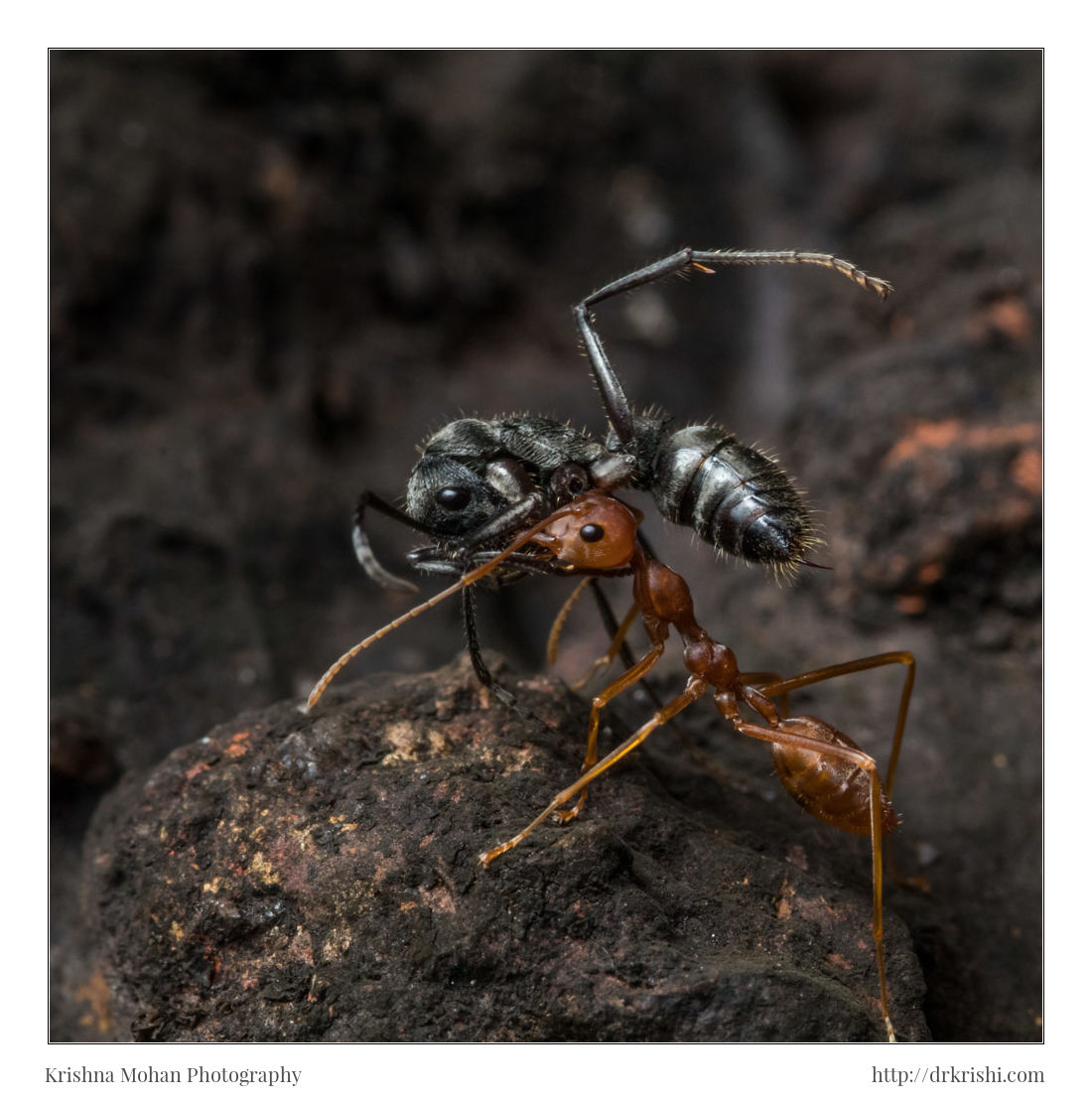
Here is a capture of Weaver Ant (Oecophylla smaragdina) workers killing a Indian Queenless Ant, also known as Lesser Striated Bispinous Ant (Diacamma indicum). These Diacamma indicum ants are native to the Indian subcontinent. Since Diacamma species forage individually and they don’t have a queen in their colony they are also called Indian queenless ant. Diacamma workers are highly distinctive and are easily identified by the presence of deep striate sculpturing, deep pits (gemmal pits) on the sides of the mesosoma, and a petiole which has two spine. This was captured with Tamron SP 90mm F/2.8 Di MACRO 1:1 VC USD on Canon EOS 80D camera and Godox Ving V860c E-TTL Li-ion Flash with modified softbox.

Indian queenless ants do not have a queen, but have a gamergate. A gamergate is a mated worker ant that is able to reproduce sexually, i.e. lay fertilized eggs that will develop as females. In gamergate species, all workers in a colony have similar reproductive potentials, but only one or a few top-ranking workers can mate (usually with foreign males) and produce eggs. The term “gamergate” here is not “gamer-gate” but “gam-ergate” and derives from the Greek words gámos and ergátes and means “married worker”.
There are 100–200 different species in which gamergates reproduce (roughly 1% of all ants), most of which fall within the poneromorph subfamilies. Whereas workers (which are all females) in most ant species are morphologically incapable of storing sperm, in gamergate species one or several workers mate and have active ovaries. Gamergate lifespan is short compared to queens in queenright colonies, but gamergates can be replaced by other dominant workers in the colony without risking colony survival. Reproductive investment in gamergate females is thus optimized because non-differentiated gamergates (i.e. reproductively inactive workers) function as laborers.

Within gamergate colonies all workers are born reproductively viable and are thus potential gamergates. Prior to differentiation as a gamergate, a dominant worker must physically inhibit its sisters. For example, in the case of Diacamma indicum shown above, the first female to become reproductively active will clip off the thoracic gemmae of her sisters. This mutilation greatly reduces their sexual attractiveness. In other genera, persistent domination of worker females by gamergates via physical aggression all but ensure that they will not produce male offspring.
In Diacamma nilgiri gamergates use dominance interactions to monopolize reproduction without mutilation of sister workers. For most gamergate species, the start of ovarian activity eliminates the need to physically dominate nestmate workers. Instead newly produced pheromones or signaling chemicals ensure that workers remain nonreproductive. Although it is unknown to what degree these chemicals act as pheromones or as signals, support for the signaling hypothesis can be found in the loss of reproductive inhibition of workers as the gamergate grows older and her fecundity diminishes.

When a gamergate dies, it is usually replaced by a formerly submissive worker who proceeds to mate and begins ovarian activity. A new gamergate often originates from a younger cohort. Because reproductively inactive workers are able to activate their ovaries after the death of the gamergate, some gamergate species can be considered cooperative breeders rather than truly eusocial insects.


How can you start a queenless colony?
Can you just start the colony with just to ants?
Dear ‘Kyle Gipulan’,
A queen caste does not exist in Diacamma. Unique to this genus, all workers emerge from cocoons with a pair of tiny innervated thoracic appendages (“gemmae”) that are homologous with wings. Mutilation leads to a permanent change in lifetime trajectory, because workers lacking gemmae never mate. This is unlike other queenless ants where workers establish a dominance hierarchy to regulate reproduction. In Diacamma only one worker retains her gemmae in each colony, she is the gamergate (mated egglaying worker), and she bites off the gemmae of newly emerged workers. Mutilation causes the degeneration of the neuronal connections between the sensory hairs on the gemma’s surface and the central nervous system, and this may explain the irreversibility of modifications in individual behaviour. Gamergate is sort of queen here. I say a sort of because she is just another worker like ant who is mated and lays egg. She does not work like queen in other ant colony.